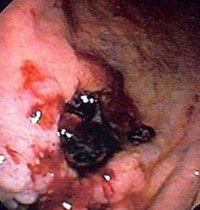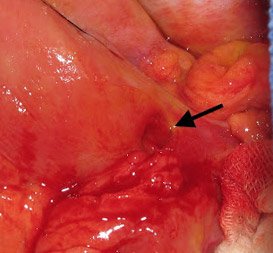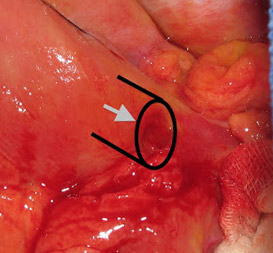"Gastroduodenal ulcer disease or a dog gastric ulcer occurs when an ulcer is an area of the stomach where the mucous membrane is damaged causing inflammation. Ulcers also form at the duodenum which is the where the small intestine meets the stomach. There are no sex, age, or breed predilections toward forming an ulcer.
The ulcers form when factors exist which overwhelm the body’s normal ability to repair the stomach’s mucosal barrier. Ulcers in dogs are usually caused by medications such as aspirin or ibuprofen. Unlike humans where bacteria are frequently the cause, in dogs it is usually related to medications. Ulcers can also form as a complication of a disease.
If the ulcer didn't form as the result of a side effect of a medication your dog is taking, the veterinarian will check for liver disease, kidney problems and stress on your dog's body from illness or surgery. Skin mas cell tumors can also cause ulcers related to the histamine produced by tumors. Ulcers are seen in 80% of dogs that has skin mast cell tumors. An ulcer can also form when the body is in shock, which can be caused by a severe bacterial infection, heart problem or blood pressure issue.
When ulcers form the dog can have gastrointestinal and cardiovascular problems (bleeding an lead to anemia, rapid heart beat, heart murmurs and low blood pressure).
Males have a higher incidence of a disorder called gastric carcinoma (stomach cancer). Treatment is specific to the determined cause."

Overview
While there are different ways a dog stomach ulcer can form, the underlying pathology is basically the same. The dog ingests something that stimulates the production of gastric acid which inhibits the gastric mucosal barrier. The process causes physical damage to the lining of the stomach and alters the natural repair process. A normal disruption heals in 3 to 7 days. When something disrupts adequate blood flow to the area or if other of the factors listed below are introduced, the body is unable to repair itself.

Causes
In addition to medications listed below, such as NSAIDs and glucocorticoids, the following disease can lead to gastroduodenal dog gastric ulcer disease.
- Medications
- piroxicam
- aspirin
- ibuprofen
- naproxen
- endomehtacine
- ketrolac
- stroidal anti inflammatory drugs
- Gastrointestinal:
- Inflammatory bowel disease (IBD)
- Tumors (neoplasia)
- Foreign bodies
- Gastric hyperacidity (high acid levels in the stomach)
- Gastric dilation volvulus (Bloat)
- Intussusception: intestines enfold into each other
- Pyloric outflow obstruction
- Household chemicals
- House Plants
- Infection
- parasites in the gastrointestinal system
- tick related diseases
- pythiosis (rare fungal disease)
- Helicobacter bacteria
- Gastroenteritis (viral, bacterial, fungal): digestive tract infection
- Kidney Failure
- Liver Disease
- Pancreatitis
- Hypoadrenocorticism (Addison's Disease)
- Poisoning (plants, chemicals, pesticides)
- Tumors (neoplasia, mastocytosis)
- Head injury
- Spinal cord diseases
- Major medical illness and stress to the body( injury, shock, burns, heat stroke)
- Strenuous exercise
- Major surgery

Symptoms
The primary and most common symptom of an ulcer is vomiting. You might see old or brownish colored blood mixed in. Other symptoms include weight loss and anemia. Note that not all dogs that vomit has an ulcer.
If the ulcers bleed rapidly, a dog can go into shock and pass tarry, black stools. Ulcers can rupture into the abdomen that results in a condition called peritonitis. Other symptoms include:
- Anorexia
- Lethargy
- Weight loss, appearing underweight
- Abdominal pain
- Change in position (praying position)
- Weakness
- Collapse (from severe anemia)
Diagnosis
A veterinarian will start with a detailed history to determine if there was any NSAID use, poison consumption or any deiseases that could trigger ulcer formation. In some dogs, symptoms such as signs of anemia (pale gums), rapid heart beat and weight loss will be noted. Pain when touched is another sign that will be noted.
Ulcers are diagnosed with a procedure called a gastroscopy. The veterinarian will also look for pale mucous membranes as a sign of anemia. Other signs are rapid heartbeat and distension of the abdomen. X-Rays are used to identify any masses in the abdomen. Ultrasounds can identify a mass or thickening of the stomach wall. Other tests include urinalysis and blood tests to determine if loss of blood causes anemia. Laboratory tests will not specificaly confirm the presence of dog stomach ulcers.
The veterinarian will eliminate other possible causes such as:
- Diseases of the esophagus
- Thrombocytopenia: abnormal drop in the number of blood cells involve din forming blood clots
- Hemoptysis: coughing up of blood from the lungs
- Regurgitation/vomiting of swallowed blood from other gastrointestinal diseases related to the urogenital tract or anal sac disease
- Taking pepto-bismol can explain stools that are tarry or black
Treatment
Ulcers are treated with drugs that are often used in humans. This includes histamine blockers such as Tagamet, Pepcid, Carafate, Cytotec, Prilosec and Zantac. Antacids such as Mylanta, Maalox and Amphogel are also used. Veterinarians often prescribe a histamine blocker and an antacid. Out patient care is warranted if the vomiting is not sever and any bleeding is minimal.
Treatment lasts for 3 to 4 weeks plus a follow-up gastroscopy to ensure that the problem has been resolved.
Ulcers that are perforated require emergency surgery. Anemia may require a blood transfusion. If bleeding is severe, bleeding can be stopped using a procedure called ice water lavage. Surgery is also indicated in cases where after 7 to 10 days of treatment, there is no improvement. After recovery a diet that is highly digestible is recommended. This means low to moderate levels of fat since fat can keep the gastric system from emptying. Fiber levels should be low. The prognosis for dogs that had ulcers due to NSAID use is good to excellent.
Brochures:
Authors: J. D. Parrah, B. A. Moulvi, Mohsin Ali Gazi, D. M. Makhdoomi, H. Athar, Shahid Dar and A. Q. Mir
Researched by: Jeff Grill
